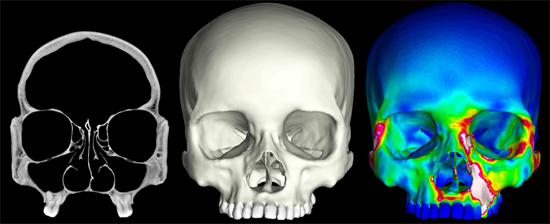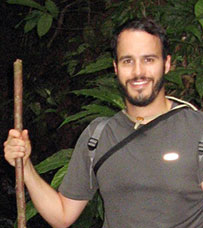Humans Pack an Efficient Bite, but at a Cost
 |
|
X-ray CT "slices" were used to construct 3D finite element models of human crania. The models were then subjected to a series of mechanical analyses that simulate feeding.
|
ALBANY, N.Y. (August 8, 2016) -- New research led by a UAlbany grad demonstrates that early humans stored and processed foods, and may help explain modern humans’ flatter, slender faces.
Justin Ledogar, who received his Ph.D. in Biological Anthropology from the University in 2015, was lead author and researcher on the study of the human jawbone.
Now a postdoctoral research fellow at the University of New England in New South Wales, Australia, Ledogar led an international team of researchers, who found the cranium of modern Homo sapiens is poorly suited to produce large biting forces because of a limitation in the jaw joint. The findings are consistent with the theory that, as early humans developed processing techniques that softened food and reduced food particle size, there was less environmental pressure to maintain the higher bite forces of our ancestors and primate relatives.
Compared with our closest living primate relatives, the human skull is striking in appearance. In addition to our unusually large brains, humans have small jaws and teeth, and faces that are thought to reflect a diet of cooked, sliced or softer foods. However, the human skull presents a puzzling contradiction: Our small and flat faces offer increased efficiency, or leverage, to the muscles involved in biting and chewing, which is something usually found in animals that subsist on foods that are difficult to chew or crack open.
"We found that humans have high biting leverage, which some previous studies have noted, but we also found that humans are at risk of dislocating, and possibly damaging, the jaw joint during powerful molar biting," said Ledogar, who conducted the study while completing his doctoral degree at UAlbany. "Additionally, we found that the human facial skeleton is generally weaker during biting than chimpanzees, which is not surprising given our small faces.”
 |
|
Lead author Justin Ledogar, '15, of the University of New England (New South Wales, Australia)
|
Ledogar’s coauthors include UAlbany Associate Professor of Anthropology Adam Gordon, along with colleagues from Texas A&M, Midwestern University, Washington University in St. Louis, the University of Vienna, UMass, the American Museum of Natural History, the Max Planck Institute for Evolutionary Anthropology, Mercer University and Kansas City University of Medicine and Biosciences.
The results suggest that human craniofacial evolution was probably not driven by selection for high magnitude unilateral biting, and that increased jaw muscle efficiency in humans is likely to be a secondary byproduct of selection for a function unrelated to forceful biting behaviors. These results are consistent with the hypothesis that a shift to softer foods and/or the innovation of food processing techniques relaxed selective pressures for a jaw that favors forceful biting, leading to the characteristically small and slender faces of modern humans.
The paper was published in the journal PeerJ. It describes biomechanical testing of computer-based models of human crania. The methods used in the new study are similar to those used by engineers to test whether machine parts or other mechanical devices are strong enough to avoid breaking during use.
"This limitation on forceful biting appears to be much more pronounced in modern humans than in chimps or many of our fossil ancestors," Ledogar said. "And because the need to bite powerfully is very unlikely to have led natural selection to favor a facial configuration that puts the feeding system at risk of being compromised, the flat faces of modern humans are probably unrelated to such behaviors."
The study does not directly address why the human face is so flat, if unrelated to powerful biting.
"We suspect that limitations on producing high bite forces may have characterized the origins of our genus," Ledogar said. "Going forward, it will be important to examine the various hypotheses that attempt to explain human facial flatness. There are a few different ideas, but we’re really not sure what was driving this unusual characteristic."
![]() For more news, subscribe to UAlbany's RSS headline feeds
For more news, subscribe to UAlbany's RSS headline feeds
A comprehensive public research university, the University at Albany-SUNY offers more than 120 undergraduate majors and minors and 125 master's, doctoral and graduate certificate programs. UAlbany is a leader among all New York State colleges and universities in such diverse fields as atmospheric and environmental sciences, business, education, public health,health sciences, criminal justice, emergency preparedness, engineering and applied sciences, informatics, public administration, social welfare and sociology, taught by an extensive roster of faculty experts. It also offers expanded academic and research opportunities for students through an affiliation with Albany Law School. With a curriculum enhanced by 600 study-abroad opportunities, UAlbany launches great careers.


